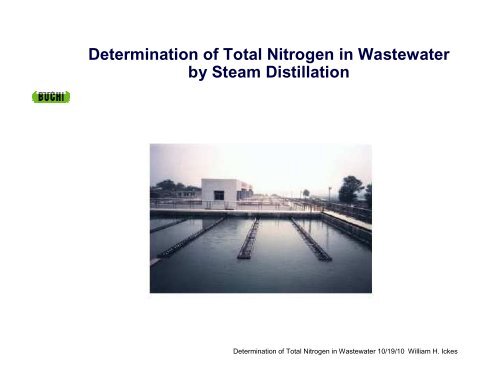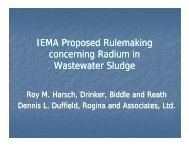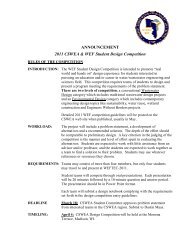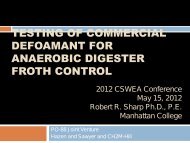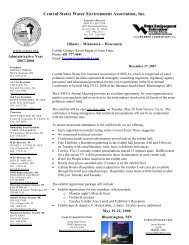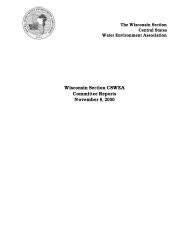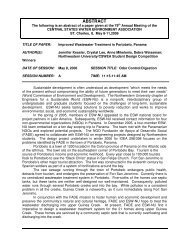Determination of Total Nitrogen in Wastewater by Steam Distillation
Determination of Total Nitrogen in Wastewater by Steam Distillation
Determination of Total Nitrogen in Wastewater by Steam Distillation
You also want an ePaper? Increase the reach of your titles
YUMPU automatically turns print PDFs into web optimized ePapers that Google loves.
<strong>Determ<strong>in</strong>ation</strong> <strong>of</strong> <strong>Total</strong> <strong>Nitrogen</strong> <strong>in</strong> <strong>Wastewater</strong><strong>by</strong> <strong>Steam</strong> <strong>Distillation</strong><strong>Determ<strong>in</strong>ation</strong> <strong>of</strong> <strong>Total</strong> <strong>Nitrogen</strong> <strong>in</strong> <strong>Wastewater</strong> 10/19/10 William H. Ickes
Bill IckesProduct Manager Kjeldahl and ExtractionBuchi CorporationBrad MillerRegional Sales ManagerBuchi Corporation<strong>Determ<strong>in</strong>ation</strong> <strong>of</strong> <strong>Total</strong> <strong>Nitrogen</strong> <strong>in</strong> <strong>Wastewater</strong> 10/19/10 William H. Ickes
Who is Buchi Corporation?<strong>Determ<strong>in</strong>ation</strong> <strong>of</strong> <strong>Total</strong> <strong>Nitrogen</strong> <strong>in</strong> <strong>Wastewater</strong> 10/19/10 William H. Ickes
Buchi HeadquartersFlawilSwitzerland<strong>Determ<strong>in</strong>ation</strong> <strong>of</strong> <strong>Total</strong> <strong>Nitrogen</strong> <strong>in</strong> <strong>Wastewater</strong> 10/19/10 William H. Ickes
Buchi Corporation• Rotavapor®• Parallel Evaporation• Industrial Evaporation• Kjeldahl Solutions• Extraction Solutions (Soxhlet, Hot, Pressurized)• Spray Dry<strong>in</strong>g• Melt<strong>in</strong>g Po<strong>in</strong>t <strong>Determ<strong>in</strong>ation</strong>• Flash and Preparative Chromatography• Near Infrared Spectroscopy• Vacuum Pumps• Chillers<strong>Determ<strong>in</strong>ation</strong> <strong>of</strong> <strong>Total</strong> <strong>Nitrogen</strong> <strong>in</strong> <strong>Wastewater</strong> 10/19/10 William H. Ickes
Buchi Corporation USA• Direct Affiliate• New Castle, DE• 37 Employees Represent<strong>in</strong>g Sales, Market<strong>in</strong>g, TechnicalSupport, Service, and Warehouse Activities<strong>Determ<strong>in</strong>ation</strong> <strong>of</strong> <strong>Total</strong> <strong>Nitrogen</strong> <strong>in</strong> <strong>Wastewater</strong> 10/19/10 William H. Ickes
Content• Introduction to <strong>Total</strong> <strong>Nitrogen</strong> Analysis• Introduction to the Kjeldahl Method• Step I: Digestion• Step II: <strong>Distillation</strong>• Step III: Titration• Calculation <strong>of</strong> <strong>Total</strong> <strong>Nitrogen</strong>• Other <strong>Steam</strong> <strong>Distillation</strong> Analysis• Summary<strong>Determ<strong>in</strong>ation</strong> <strong>of</strong> <strong>Total</strong> <strong>Nitrogen</strong> <strong>in</strong> <strong>Wastewater</strong> 10/19/10 William H. Ickes
Introduction to Analysis <strong>of</strong> <strong>Total</strong> <strong>Nitrogen</strong><strong>Determ<strong>in</strong>ation</strong> <strong>of</strong> <strong>Total</strong> <strong>Nitrogen</strong> <strong>in</strong> <strong>Wastewater</strong> 10/19/10 William H. Ickes
What is <strong>Total</strong> <strong>Nitrogen</strong>?• Ammonia (Volatile Gas)• Ammonium Salts (Ex. Ammonium Sulfate)• Organic <strong>Nitrogen</strong> (Derived from Prote<strong>in</strong>, Urea, NucleicAcids, etc.)• Nitrates• Nitrites<strong>Determ<strong>in</strong>ation</strong> <strong>of</strong> <strong>Total</strong> <strong>Nitrogen</strong> <strong>in</strong> <strong>Wastewater</strong> 10/19/10 William H. Ickes
Why Analyze for <strong>Total</strong> <strong>Nitrogen</strong>?• Good Indicator <strong>of</strong> Water Quality• Clues to <strong>Nitrogen</strong> Source• Comparison Between Influent and Effluent Waste Water• Determ<strong>in</strong>es Waste Water Treatment Efficiency<strong>Determ<strong>in</strong>ation</strong> <strong>of</strong> <strong>Total</strong> <strong>Nitrogen</strong> <strong>in</strong> <strong>Wastewater</strong> 10/19/10 William H. Ickes
Differences <strong>in</strong> Analysis• Ammonia – Direct steam distillation <strong>of</strong> sample with noaddition <strong>of</strong> NaOH• Ammonium Salts – Direct steam distillation <strong>of</strong> samplewith addition <strong>of</strong> NaOH• Organic <strong>Nitrogen</strong> – Digestion, <strong>Distillation</strong>, and Titration <strong>by</strong>Kjeldahl Method• Nitrates/Nitrites – Digestion, <strong>Distillation</strong>, and Titration <strong>by</strong>Kjeldahl Method with the addition <strong>of</strong> Devarda’s Alloy priorto distillation<strong>Determ<strong>in</strong>ation</strong> <strong>of</strong> <strong>Total</strong> <strong>Nitrogen</strong> <strong>in</strong> <strong>Wastewater</strong> 10/19/10 William H. Ickes
Introduction to the Kjeldahl Method<strong>Determ<strong>in</strong>ation</strong> <strong>of</strong> <strong>Total</strong> <strong>Nitrogen</strong> <strong>in</strong> <strong>Wastewater</strong> 10/19/10 William H. Ickes
Who was Kjeldahl?Johan Kjeldahl 1849 – 19001849 born <strong>in</strong> Denmark1867 graduation from university1876 Scientist at Carlsberg Breweries Fermentation studies Development <strong>of</strong> a method for exact determnation<strong>of</strong> nitrogen <strong>in</strong> animal and vegetablematerial Research on carbohydrates <strong>in</strong> barley and malt1883 Publication <strong>of</strong> the Kjeldahl method<strong>Determ<strong>in</strong>ation</strong> <strong>of</strong> <strong>Total</strong> <strong>Nitrogen</strong> <strong>in</strong> <strong>Wastewater</strong> 10/19/10 William H. Ickes
Pr<strong>in</strong>ciple Kjeldahl Method1.DigestionConversion <strong>of</strong>Prote<strong>in</strong>-<strong>Nitrogen</strong> toNH 4+2.3.<strong>Distillation</strong> TitrationSeparation <strong>of</strong> Measure <strong>of</strong>NH the Amount <strong>of</strong>3Acid that wasneutralised <strong>by</strong>NH 3<strong>Determ<strong>in</strong>ation</strong> <strong>of</strong> <strong>Total</strong> <strong>Nitrogen</strong> <strong>in</strong> <strong>Wastewater</strong> 10/19/10 William H. Ickes
Step 1: Digestion<strong>Determ<strong>in</strong>ation</strong> <strong>of</strong> <strong>Total</strong> <strong>Nitrogen</strong> <strong>in</strong> <strong>Wastewater</strong> 10/19/10 William H. Ickes
DigestionTarget <strong>of</strong> digestion: Breakage <strong>of</strong> organic bonds Conversion <strong>of</strong> <strong>Nitrogen</strong> to AmmoniumOrganic N NH 4+H 2 SO 4 conc.Digestion Mixture<strong>Determ<strong>in</strong>ation</strong> <strong>of</strong> <strong>Total</strong> <strong>Nitrogen</strong> <strong>in</strong> <strong>Wastewater</strong> 10/19/10 William H. Ickes
Digestion Mixture Digestion mixture is a mixture <strong>of</strong>- a salt (i.g. potassium or sodium sulphate)- and a catalyst (Hg, Se, Cu or Ti) Reason for addition <strong>of</strong> digestion mixtureIncreas<strong>in</strong>g <strong>of</strong> the digestion temperature→ faster and more efficient digestionImportant for reproducible results:Ratio <strong>of</strong> sulphuric acid and digestion mixtureIdeal proportion: 20ml/10g<strong>Determ<strong>in</strong>ation</strong> <strong>of</strong> <strong>Total</strong> <strong>Nitrogen</strong> <strong>in</strong> <strong>Wastewater</strong> 10/19/10 William H. Ickes
RatioSulphuric Acid – Digestion MixtureThe ratio sulphuric acid – digestion mixture def<strong>in</strong>esthe boil<strong>in</strong>g po<strong>in</strong>t <strong>of</strong> the sulphuric acidIdeal digestion temperature: 370°CQuantityH 2 SO 4QuantityK 2 SO 4Boill<strong>in</strong>gpo<strong>in</strong>tRemarks20 ml -- 330 °C pure H 2 SO 420 ml 5 g 350 °C20 ml 10 g 370 °C20 ml 15 g 390 °Coptimaldigestion temp.already firstnitrogen loss<strong>Determ<strong>in</strong>ation</strong> <strong>of</strong> <strong>Total</strong> <strong>Nitrogen</strong> <strong>in</strong> <strong>Wastewater</strong> 10/19/10 William H. Ickes
Summary Digestion (I)Sample Homogenisation, Weigh<strong>in</strong>gand Addition <strong>of</strong> ReagentsSample2 tabs <strong>of</strong>CatalystSulphuric acidDigestion1.072BlankWeigh sample• 1 g <strong>of</strong> dry organic material(homogeneous)Add reagents• 10 g or 2 tabs <strong>of</strong> Kjeldahlcatalyst mixture• 20 ml <strong>of</strong> H 2 SO 4Sample Blank• add everyth<strong>in</strong>g exceptsample<strong>Determ<strong>in</strong>ation</strong> <strong>of</strong> <strong>Total</strong> <strong>Nitrogen</strong> <strong>in</strong> <strong>Wastewater</strong> 10/19/10 William H. Ickes
Summary Digestion (II)Digestionvapours toScrubberDigestion• digest at 370 °C for 90 m<strong>in</strong>or until the mixture is clear(green / blue color) + 30 m<strong>in</strong>Digestion<strong>Determ<strong>in</strong>ation</strong> <strong>of</strong> <strong>Total</strong> <strong>Nitrogen</strong> <strong>in</strong> <strong>Wastewater</strong> 10/19/10 William H. Ickes
Step 2: <strong>Distillation</strong>Step 3: Titration<strong>Determ<strong>in</strong>ation</strong> <strong>of</strong> <strong>Total</strong> <strong>Nitrogen</strong> <strong>in</strong> <strong>Wastewater</strong> 10/19/10 William H. Ickes
Pre-<strong>Distillation</strong> Steps1) Cool<strong>in</strong>gDigested sample is cooled down to RT2) DilutionDigested sample is diluted with deionised water3) Preparation <strong>of</strong> receiv<strong>in</strong>g vesselReceiv<strong>in</strong>g solution necessary to capture volatileammonia<strong>Determ<strong>in</strong>ation</strong> <strong>of</strong> <strong>Total</strong> <strong>Nitrogen</strong> <strong>in</strong> <strong>Wastewater</strong> 10/19/10 William H. Ickes
Preparation <strong>of</strong> Receiv<strong>in</strong>g Vessel (I) Reason for receiv<strong>in</strong>g vessel:Ammonia is volatile -> has to be captured <strong>in</strong>receiv<strong>in</strong>g solution Possibilities for receiv<strong>in</strong>g solutions:Boric acid solution (2% or 4%)M<strong>in</strong>eral acid standard solution (HCl or H 2 SO 4 )<strong>Determ<strong>in</strong>ation</strong> <strong>of</strong> <strong>Total</strong> <strong>Nitrogen</strong> <strong>in</strong> <strong>Wastewater</strong> 10/19/10 William H. Ickes
Preparation <strong>of</strong> Receiv<strong>in</strong>g Vessel (II)Recommendation for Kjeldahl determ<strong>in</strong>ation:Boric Acid 4% Easier handl<strong>in</strong>g No risk <strong>of</strong> too low capacity to capture all NH 3 Method <strong>of</strong> most <strong>of</strong>ficial methods<strong>Steam</strong> <strong>Distillation</strong>NH 3Receiv<strong>in</strong>g AcidNH 4 [B(OH) 4 ](Boric Acid)<strong>Determ<strong>in</strong>ation</strong> <strong>of</strong> <strong>Total</strong> <strong>Nitrogen</strong> <strong>in</strong> <strong>Wastewater</strong> 10/19/10 William H. Ickes
<strong>Distillation</strong>: Addition <strong>of</strong> NaOHTarget <strong>of</strong> addition <strong>of</strong> NaOH:Release <strong>of</strong> ammonia <strong>in</strong> the form <strong>of</strong> NH 3NaOH(NH 4 ) 2 SO 4 NH 3<strong>Determ<strong>in</strong>ation</strong> <strong>of</strong> <strong>Total</strong> <strong>Nitrogen</strong> <strong>in</strong> <strong>Wastewater</strong> 10/19/10 William H. Ickes
Titration Possibilities <strong>of</strong> titration methods- potentiometric titration (pH)- visual titration (colour)- colorimetric titration (absorbance)Recommendation for Kjeldahl determ<strong>in</strong>ation:Potentiometric titration Advantages potentiometric titration:- more precise than visual and colorimetric titration- more robust than colorimetric titration(colorimetric titration is very susceptible)<strong>Determ<strong>in</strong>ation</strong> <strong>of</strong> <strong>Total</strong> <strong>Nitrogen</strong> <strong>in</strong> <strong>Wastewater</strong> 10/19/10 William H. Ickes
Potentiometric TitrationPo<strong>in</strong>ts to consider: Initial pH <strong>of</strong> the boric acid should be 4.65 Endpo<strong>in</strong>t <strong>of</strong> the titration should be pH 4.65Reason: pH 4.65 is turn<strong>in</strong>g po<strong>in</strong>t <strong>of</strong> the titration curvemLEnd po<strong>in</strong>t pH 4.65Warn<strong>in</strong>g po<strong>in</strong>tpH3.0 4.0 5.0 6.0 7.0 8.0<strong>Determ<strong>in</strong>ation</strong> <strong>of</strong> <strong>Total</strong> <strong>Nitrogen</strong> <strong>in</strong> <strong>Wastewater</strong> 10/19/10 William H. Ickes
Summary <strong>Distillation</strong> / Titration (I)DilutionmanuallyorautomatedDilution• dilute the cooled digestionsolution with 50 ml deionisedwater<strong>Determ<strong>in</strong>ation</strong> <strong>of</strong> <strong>Total</strong> <strong>Nitrogen</strong> <strong>in</strong> <strong>Wastewater</strong> 10/19/10 William H. Ickes
Summary <strong>Distillation</strong> / Titration (II)Preparation <strong>of</strong> ReceiverBoric acid titration• add 60 ml <strong>of</strong> Boric acid 4%• add 2 to 3 drops <strong>of</strong> <strong>in</strong>dicatoraccord<strong>in</strong>g to Sher<strong>Determ<strong>in</strong>ation</strong> <strong>of</strong> <strong>Total</strong> <strong>Nitrogen</strong> <strong>in</strong> <strong>Wastewater</strong> 10/19/10 William H. Ickes
Summary <strong>Distillation</strong> / Titration (III)Neutralisation and <strong>Distillation</strong>Sodium hydroxide• add 90 ml <strong>of</strong> NaOH 32% tothe diluted digestion solution<strong>Distillation</strong>• distill for 4 m<strong>in</strong>.<strong>Determ<strong>in</strong>ation</strong> <strong>of</strong> <strong>Total</strong> <strong>Nitrogen</strong> <strong>in</strong> <strong>Wastewater</strong> 10/19/10 William H. Ickes
Summary <strong>Distillation</strong> / Titration (IV)Titration7.15Boric acid titration• titrate the condensate withsulphuric acid standard solution(0.5 N or equivalent) to the endpo<strong>in</strong>t <strong>of</strong> pH 4.65<strong>Determ<strong>in</strong>ation</strong> <strong>of</strong> <strong>Total</strong> <strong>Nitrogen</strong> <strong>in</strong> <strong>Wastewater</strong> 10/19/10 William H. Ickes
Calculation<strong>Determ<strong>in</strong>ation</strong> <strong>of</strong> <strong>Total</strong> <strong>Nitrogen</strong> <strong>in</strong> <strong>Wastewater</strong> 10/19/10 William H. Ickes
Calculation% N =% P =(Consumption-Blank) x 1.4007 x n x 100Sample Size(Consumption-Blank) x 1.4007 x n x PF x 100Sample Size1.4007: 1 ml 0.1 N Volumetric Solution = 1.4007 mg Nn: Normality AcidPF:Prote<strong>in</strong> factor N Prote<strong>in</strong>(e.g. 6.25; Milk Sample 6.38; Nuts 5.4)<strong>Determ<strong>in</strong>ation</strong> <strong>of</strong> <strong>Total</strong> <strong>Nitrogen</strong> <strong>in</strong> <strong>Wastewater</strong> 10/19/10 William H. Ickes
Other Methods <strong>of</strong> Analysis w/ <strong>Steam</strong> <strong>Distillation</strong><strong>Determ<strong>in</strong>ation</strong> <strong>of</strong> <strong>Total</strong> <strong>Nitrogen</strong> <strong>in</strong> <strong>Wastewater</strong> 10/19/10 William H. Ickes
Analysis Us<strong>in</strong>g <strong>Steam</strong> <strong>Distillation</strong>• Cyanides• Phenols• Volatile Acids<strong>Determ<strong>in</strong>ation</strong> <strong>of</strong> <strong>Total</strong> <strong>Nitrogen</strong> <strong>in</strong> <strong>Wastewater</strong> 10/19/10 William H. Ickes
Cyanide <strong>Determ<strong>in</strong>ation</strong><strong>Determ<strong>in</strong>ation</strong> <strong>of</strong> <strong>Total</strong> <strong>Nitrogen</strong> <strong>in</strong> <strong>Wastewater</strong> 10/19/10 William H. Ickes
Method Reference: EPA Method 9010 C/335.2<strong>Determ<strong>in</strong>ation</strong> <strong>of</strong> Free Cyanide and Weak AcidDissociable Cyanide In Waste Water<strong>Determ<strong>in</strong>ation</strong> <strong>of</strong> <strong>Total</strong> <strong>Nitrogen</strong> <strong>in</strong> <strong>Wastewater</strong> 10/19/10 William H. Ickes
Why Analyze For Cyanide?• One <strong>of</strong> Natures Toxic Substances<strong>Determ<strong>in</strong>ation</strong> <strong>of</strong> <strong>Total</strong> <strong>Nitrogen</strong> <strong>in</strong> <strong>Wastewater</strong> 10/19/10 William H. Ickes
Sources <strong>of</strong> Cyanide?• Metal F<strong>in</strong>ish<strong>in</strong>g• Photographic Bleach<strong>in</strong>g• Galvanic Industry Waste Water<strong>Determ<strong>in</strong>ation</strong> <strong>of</strong> <strong>Total</strong> <strong>Nitrogen</strong> <strong>in</strong> <strong>Wastewater</strong> 10/19/10 William H. Ickes
How is Cyanide Analyzed?• <strong>Steam</strong> distillation with strong acid• Collected <strong>in</strong> a receiv<strong>in</strong>g solution <strong>of</strong> NaOH• Cyanide concentration determ<strong>in</strong>ed colorimetrically at578nm<strong>Determ<strong>in</strong>ation</strong> <strong>of</strong> <strong>Total</strong> <strong>Nitrogen</strong> <strong>in</strong> <strong>Wastewater</strong> 10/19/10 William H. Ickes
Phenol <strong>Determ<strong>in</strong>ation</strong><strong>Determ<strong>in</strong>ation</strong> <strong>of</strong> <strong>Total</strong> <strong>Nitrogen</strong> <strong>in</strong> <strong>Wastewater</strong> 10/19/10 William H. Ickes
Method Reference: EPA Method 9065<strong>Determ<strong>in</strong>ation</strong> <strong>of</strong> Phenolic Material <strong>by</strong>Spectrophotometric 4-am<strong>in</strong>oantipyr<strong>in</strong>e Method<strong>Determ<strong>in</strong>ation</strong> <strong>of</strong> <strong>Total</strong> <strong>Nitrogen</strong> <strong>in</strong> <strong>Wastewater</strong> 10/19/10 William H. Ickes
Why Analyze for Phenols?• Phenolic compounds are commonly found <strong>in</strong> sludge• Phenolic compounds can be traced to differentcontam<strong>in</strong>ation sources<strong>Determ<strong>in</strong>ation</strong> <strong>of</strong> <strong>Total</strong> <strong>Nitrogen</strong> <strong>in</strong> <strong>Wastewater</strong> 10/19/10 William H. Ickes
Sources <strong>of</strong> Phenols?• Plant Material• Chemical Industry Processes• Wood Process<strong>in</strong>g• Plastic Process<strong>in</strong>g<strong>Determ<strong>in</strong>ation</strong> <strong>of</strong> <strong>Total</strong> <strong>Nitrogen</strong> <strong>in</strong> <strong>Wastewater</strong> 10/19/10 William H. Ickes
How are Phenols Analyzed?• <strong>Steam</strong> distillation <strong>in</strong> the presence <strong>of</strong> acid• Collected <strong>in</strong> water <strong>in</strong> the receiv<strong>in</strong>g solution• Photometric measurement <strong>of</strong> the receiv<strong>in</strong>g solution<strong>Determ<strong>in</strong>ation</strong> <strong>of</strong> <strong>Total</strong> <strong>Nitrogen</strong> <strong>in</strong> <strong>Wastewater</strong> 10/19/10 William H. Ickes
Volatile Acids <strong>Determ<strong>in</strong>ation</strong><strong>Determ<strong>in</strong>ation</strong> <strong>of</strong> <strong>Total</strong> <strong>Nitrogen</strong> <strong>in</strong> <strong>Wastewater</strong> 10/19/10 William H. Ickes
Method Reference: Buchi Application Note K-355.004 Version A<strong>Determ<strong>in</strong>ation</strong> <strong>of</strong> Volatile Acids <strong>in</strong> Sludge<strong>Determ<strong>in</strong>ation</strong> <strong>of</strong> <strong>Total</strong> <strong>Nitrogen</strong> <strong>in</strong> <strong>Wastewater</strong> 10/19/10 William H. Ickes
Why Analyze for Volatile Acids?• Ratio <strong>of</strong> volatile acids -> total alkal<strong>in</strong>ity content <strong>in</strong> sludgesubmitted to anaerobic conditions is a good <strong>in</strong>dex <strong>of</strong>process performance <strong>in</strong>hibition<strong>Determ<strong>in</strong>ation</strong> <strong>of</strong> <strong>Total</strong> <strong>Nitrogen</strong> <strong>in</strong> <strong>Wastewater</strong> 10/19/10 William H. Ickes
Source <strong>of</strong> Volatile Acids?• Acetic Acid<strong>Determ<strong>in</strong>ation</strong> <strong>of</strong> <strong>Total</strong> <strong>Nitrogen</strong> <strong>in</strong> <strong>Wastewater</strong> 10/19/10 William H. Ickes
How are Volatile Acids Analyzed?• <strong>Steam</strong> <strong>Distillation</strong>• Titration<strong>Determ<strong>in</strong>ation</strong> <strong>of</strong> <strong>Total</strong> <strong>Nitrogen</strong> <strong>in</strong> <strong>Wastewater</strong> 10/19/10 William H. Ickes
Questions?<strong>Determ<strong>in</strong>ation</strong> <strong>of</strong> <strong>Total</strong> <strong>Nitrogen</strong> <strong>in</strong> <strong>Wastewater</strong> 10/19/10 William H. Ickes


